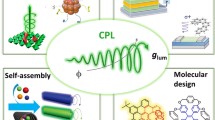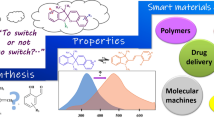Abstract
Ground- and excited-state intramolecular proton transfer reactions, as one of the most important processes in biological systems, have been utilized as the basis of artificially designed molecular photoswitch. Taking 7-azaindole as model of study, we report the electric field tuning of water-assisted proton transfer reactions in both the ground and excited states, by applying static electric fields along various directions. The electric fields applied in the direction (or those with component in the direction) of net proton transfer path have remarkable impact on the energetics of reaction, including tuning of thermodynamic and kinetic balance of tautomers, as well as red-/blueshifting the absorption and emission maxima. The electric fields applied in a direction perpendicular to the net proton transfer, although which have been found to play negligible roles in changing the energetics, tune the concerted double-proton transfer reactions from roughly synchronic to asynchronic. The electrostatic origins of such influences are analyzed. The findings of our (TD)-DFT calculations provide insights into fine tuning of both energetic and mechanistic aspects of reversible systems by electric field, and shed light on the nature of proton transfer in natural systems as well as designing novel electric optical switches.







Similar content being viewed by others
References
Raymo FM, Giordani S (2002) All-optical processing with molecular switches. Proc Natl Acad Sci USA 99:4941–4944
Gorostiza P, Isacoff E (2007) Optical switches and triggers for the manipulation of ion channels and pores. Mol BioSyst 3:686–704
Silvi S, Constable EC, Housecroft CE, Beves JE, Dunphy EL, Tomasulo M, Raymo FM, Credi A (2009) All-optical integrated logic operations based on chemical communication between molecular switches. Chem Eur J 15:178–185
Hsieh C-C, Jiang C-M, Chou P-T (2010) Recent experimental advances on excited-state intramolecular proton coupled electron transfer reaction. Acc Chem Res 43:1364–1374
Ghanbari M, Jadidi K, Mehrdad M, Assempour N (2016) A simple route for the synthesis of novel 1,4-benzoxazine derivatives by Baeyer–Villiger oxidation reaction. Tetrahedron 72:4355–4360
Lim S-J, Seo J, Park SY (2006) Photochromic switching of excited-state intramolecular proton-transfer (ESIPT) fluorescence: a unique route to high-contrast memory switching and nondestructive readout. J Am Chem Soc 128:14542–14547
Lapinski L, Nowak MJ, Nowacki J, Rode MF, Sobolewski AL (2009) A bistable molecular switch driven by photoinduced hydrogen-atom transfer. Chem Phys Chem 10:2290–2295
Jankowska J, Sadlej J, Sobolewski AL (2015) Electric field control of proton-transfer molecular switching: molecular dynamics study on salicylidene aniline. Phys Chem Chem Phys 17:14484–14488
Padalkar VS, Seki S (2016) Excited-state intramolecular proton-transfer (ESIPT)-inspired solid state emitters. Chem Soc Rev 45:169–202
Brousmiche DW, Wan P (2000) Excited state (formal) intramolecular proton transfer (ESIPT) in p-hydroxyphenyl ketones mediated by water. J Photochem Photobiol, A 130:113–118
Nayak MK, Wan P (2008) Direct and water-mediated excited state intramolecular proton transfer (ESIPT) from phenol OH to carbon atoms of extended ortho-substituted biaryl systems. Photochem Photobiol Sci 7:1544–1554
Tang KC, Chang MJ, Lin TY, Pan HA, Fang TC, Chen KY, Hung WY, Hsu YH, Chou PT (2011) Fine tuning the energetics of excited-state intramolecular proton transfer (ESIPT): white light generation in a single ESIPT system. J Am Chem Soc 133:17738–17745
Azarias C, Budzák Š, Laurent AD, Ulrich G, Jacquemin D (2016) Tuning ESIPT fluorophores into dual emitters. Chem Sci 7:3763–3774
Houari Y, Charaf-Eddin A, Laurent AD, Massue J, Ziessel R, Ulrich G, Jacquemin D (2014) Modeling optical signatures and excited-state reactivities of substituted hydroxyphenylbenzoxazole (HBO) ESIPT dyes. Phys Chem Chem Phys 16:1319–1321
Savarese M, Netti PA, Adamo C, Rega N, Ciofini I (2013) Intermolecular proton shuttling in excited state proton transfer reactions: insights from theory. J Phys Chem B 117:16165
Xia S-H, Xie B-B, Fang Q, Cui G, Thiel W (2015) Excited-state intramolecular proton transfer to carbon atoms: nonadiabatic surface-hopping dynamics simulations. Phys Chem Chem Phys 17:9687–9697
Plasser F, Barbatti M, Aquino AJA, Lischka H (2009) Excited-state diproton transfer in [2,2′-Bipyridyl]-3,3′-diol: the mechanism is sequential, not concerted. J Phys Chem A 113:8490
Vetokhina V, Nowacki J, Pietrzak M, Rode MF, Sobolewski AL, Waluk J, Herbich J (2013) 7-hydroxyquinoline-8-carbaldehydes. 1. ground- and excited-state long-range prototropic tautomerization. J Phys Chem A 117:2411–2502
Meir R, Chen H, Lai W, Shaik S (2010) Oriented electric fields accelerate Diels–Alder reactions and control the endo/exo selectivity. Chem Phys Chem 11:301–310
Furukawa K, Hino K, Yamamoto N, Awasthi K, Nakabayashi T, Ohta N, Sekiya H (2015) External electric field effects on excited-state intramolecular proton transfer in 4′-N, N-dimethylamino-3-hydroxyflavone in poly(methyl methacrylate) films. J Phys Chem A 119:9599–9608
Gurav ND, Kulkarni AD, Gejji SP, Pathak RK (2015) CH3OH… (H2O)n [n = 1–4] clusters in external electric fields. J Chem Phys 142:214309
Wei Y, Wang X, Wang X, Tao Z, Cui Y, Yang M (2016) A theoretical study of the activation of nitromethane under applied electric fields. RSC Adv 6:24712–24718
Dutta BJ, Bhattacharyya PK (2014) Reactivity and aromaticity of nucleobases are sensitive toward external electric field. J Phys Chem B 118:9573–9582
Arabi AA, Matta CF (2011) Effects of external electric fields on double proton transfer kinetics in the formic acid dimer. Phys Chem Chem Phys 12:13738–13748
Cerón-Carrasco JP, Jacquemin D (2013) Electric field induced DNA damage: an open door for selective mutations. Chem Commun 49:7578–7580
Alemani M, Peters MV, Hecht S, Rieder K-H, Moresco F, Grill L (2006) Electric field-induced isomerization of azobenzene by STM. J Am Chem Soc 128:14446–14447
Aragonès AC, Haworth NL, Darwish N, Ciampi S, Bloomfield NJ, Wallace GG, Diez-Perez I, Coote ML (2016) Electrostatic catalysis of a Diels–Alder reaction. Nature 531:88–91
Wen J, Tian Z, Ma J (2013) Light- and electric-field-induced switching of thiolated azobenzene self-assembled monolayer. J Phys Chem C 117:19934–19944
Chaban GM, Gordon MS (1999) The ground and excited state hydrogen transfer potential energy surface in 7-azaindole. J Phys Chem A 103:185–189
Catalán J, del Valle JC, Kasha M (1999) Resolution of concerted versus sequential mechanisms in photo-induced double-proton transfer reaction in 7-azaindole H-bonded dimer. Proc Natl Acad Sci USA 96:8338–8343
Takeuchi S, Tahara T (2007) The answer to concerted versus step-wise controversy for the double proton transfer mechanism of 7-azaindole dimer in solution. Proc Natl Acad Sci USA 104:5285–5290
Daengngern R, Kerdpol K, Kungwan N, Hannongbua S, Barbatti M (2013) Dynamics simulations of excited-state triple proton transfer in 7-azaindole complexes with water, water–methanol and methanol. J Photochem Photobiol, A 266:28–36
Bauernschmitt R, Ahlrichs R (1996) Treatment of electronic excitations within the adiabatic approximation of time dependent density functional theory. Chem Phys Lett 256:454–464
Becke AD (1993) Density-functional thermochemistry. III. The role of exact exchange. J Chem Phys 98:5648–5653
Bauernschmitt R, Ahlrichs R (1996) Treatment of electronic excitations within the adiabatic approximation of time dependent density functional theory. Chem Phys Lett 256:454–464
Casida ME, Jamorski C, Casida KC, Salahub DR (1998) Molecular excitation energies to high-lying bound states from time-dependent density-functional response theory: characterization and correction of the time-dependent local density approximation ionization threshold. J Chem Phys 108:4439–4449
Adamo C, Jacquemin D (2013) The calculations of excited-state properties with time-dependent density functional theory. Chem Soc Rev 44:845–856
Yanai T, Tew DP, Handy NC (2004) A new hybrid exchange-correlation functional using the Coulomb-attenuating method (CAM-B3LYP). Chem Phys Lett 393:51–57
Krishnan R, Binkley JS, Seeger R, Pople JA (1980) Self consistent molecular orbital methods. A basis set for correlated wave functions. J Chem Phys 72:650–654
Tomasi J, Mennucci B, Cammi R (2005) Quantum mechanical continuum solvation models. Chem Rev 105:2999–3094
Chou PT, Martinez ML, Cooper WC, Collins ST, McMorrow DP, Kasha M (1992) Monohydrate catalysis of excited-state double-proton transfer in 7-azaindole. J Phys Chem 96:5203–5205
Scalmani G, Frisch MJ, Mennucci B, Tomasi J, Cammi R, Barone V (2006) Geometries and properties of excited states in the gas phase and in solution: theory and application of a time-dependent density functional theory polarizable continuum model. J Chem Phys 124:3338–3348
Badger RM, Bauer SH (1937) Spectroscopic studies of the hydrogen bond. II. The shift of the O–H vibrational frequency in the formation of the hydrogen bond. J Chem Phys 5:839–851
Wong MW (1996) Vibrational frequency prediction using density functional theory. Chem Phys Lett 256:391–399
Broda MA, Buczek A, Kupka T, Kaminsky J (2012) Anharmonic vibrational frequency calculations for solvated molecules in the B3LYP Kohn–Sham basis set limit. Vib Spectrosc 63:432–439
Fukui K (1981) The path of chemical reactions—The IRC approach. Acc Chem Res 14:363–368
Raucci U, Savarese M, Adamo C, Ciofini I, Rega N (2015) Intrinsic and dynamical reaction pathways of an excited state proton transfer. J Phys Chem B 119:2650–2657
Karafiloglou P (2006) Control of delocalization and structural changes by means of an electric field. J Comput Chem 27:1883–1891
Shevkunov SV, Vegiri A (2001) Equilibrium structures of the N = 64 water cluster in the presence of external electric fields. J Chem Phys 574:27–38
Schkolnik G, Utesch T, Salewski J, Tenger K, Millo D, Kranich A, Zebger I, Schulz C, Zimányi L, Rákhely G, Mroginski MA, Hildebrandt P (2012) Mapping local electric fields in proteins at biomimetic interfaces. Chem Commun (Camb) 48:70–72
Knoch F, Morozov D, Boggio-Pasqua M, Groenhof G (2014) Steering the excited state dynamics of a photoactive yellow protein chromophore analogue with external electric fields. Comput Theor Chem 1040–1041:120–125
Frisch MJ, Trucks GW, Schlegel HB, Scuseria GE, Robb MA, Cheeseman JR, Montgomery JA, Vreven T, Kudin KN, Burant JC, Millam JM, Iyengar SS, Tomasi J, Barone V, Mennucci B, Cossi M, Scalmani G, Rega N, Petersson GA, Nakatsuji H, Hada M, Ehara M, Toyota K, Fukuda R, Hasegawa J, Ishida M, Nakajima T, Honda Y, Kitao O, Nakai H, Klene M, Li X, Knox JR, Hratchian HP, Cross JB, Bakken V, Adamo C, Jaramillo J, Gomperts R, Stratmann RE, Yazyev O, Austin AJ, Cammi R, Pomelli C, Ochterski JW, Ayala PY, Morokuma K, Voth GA, Salvador P, Dannenberg JJ, Zakrzewski VG, Dapprich S, Daniels AD, Strain MC, Farkas O, Malick DK, Rabuck AD, Raghavachari K, Foresman JB, Ortiz JV, Cui Q, Baboul AG, Clifford S, Cioslowski J, Stefanov BB, Liu G, Liashenko A, Piskorz P, Komaromi I, Martin RL, Fox DJ, Keith T, Al-Laham MA, Peng CY, Nanayakkara A, Challacombe M, Gill PMW, Johnson B, Chen W, Wong MW, Gonzalez C, Pople JA (2009) Gaussian 09, revision A.02. Gaussian Inc., Wallingford
Kwon OH, Lee YS, Park HJ, Kim Y, Jang DJ (2004) Asymmetric double proton transfer of excited 1:1 7-azaindole/alcohol complexes with anomalously large and temperature-independent kinetic isotope effects. Angew Chem Int Ed Engl 43:5792–5796
Duong MPT, Park K, Kim Y (2010) Excited state double proton transfer of a 1:1 7-azaindole: H2O complex and the breakdown of the rule of the geometric mean: Variational transition state theory studies including multidimensional tunneling. J Photochem Photobiol, A 214:100–107
Park SY, Jeong H, Jang DJ (2011) Anomalously slow proton transport of a water molecule. J Phys Chem B 115:6023–6031
Mente S, Maroncelli M (1998) Solvation and the excited-state tautomerization of 7-azaindole and 1-azacarbazole: computer simulations in water and alcohol solvents. J Phys Chem A 102:3860–3876
Lim H, Park SY, Jang DJ (2011) Excited-state double proton transfer of 7-azaindole dimers in a low-temperature organic glass. Photochem Photobiol 87:766–771
Acknowledgements
This work is in supported by grants from the NSFC (Grant Nos. 21473107), Natural Science Basic Research Plan in Shaanxi Province of China (Grant No. 2015JM2056), and Fundamental Research Funds for the Central Universities (Grant No. GK201502002) and Program for Changjiang Scholars and Innovative Research Team in University (IRT_14R33).
Author information
Authors and Affiliations
Corresponding author
Electronic supplementary material
Below is the link to the electronic supplementary material.
Rights and permissions
About this article
Cite this article
Li, Y., Li, Y., Su, Q. et al. Tuning of energetics and reaction mechanism of water-assisted intramolecular proton transfer of 7-azaindole by external electric field applied in various directions: a TD-DFT study. Theor Chem Acc 136, 27 (2017). https://doi.org/10.1007/s00214-017-2052-8
Received:
Accepted:
Published:
DOI: https://doi.org/10.1007/s00214-017-2052-8




